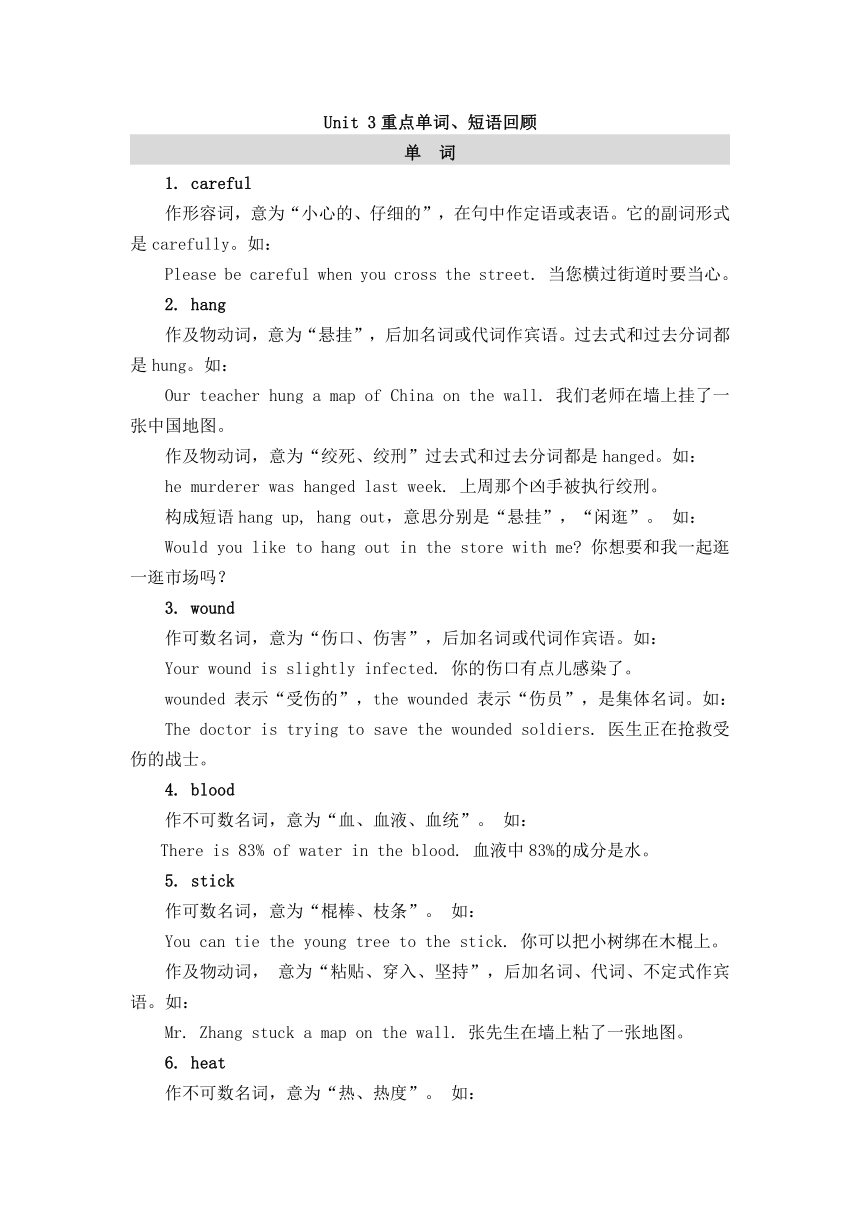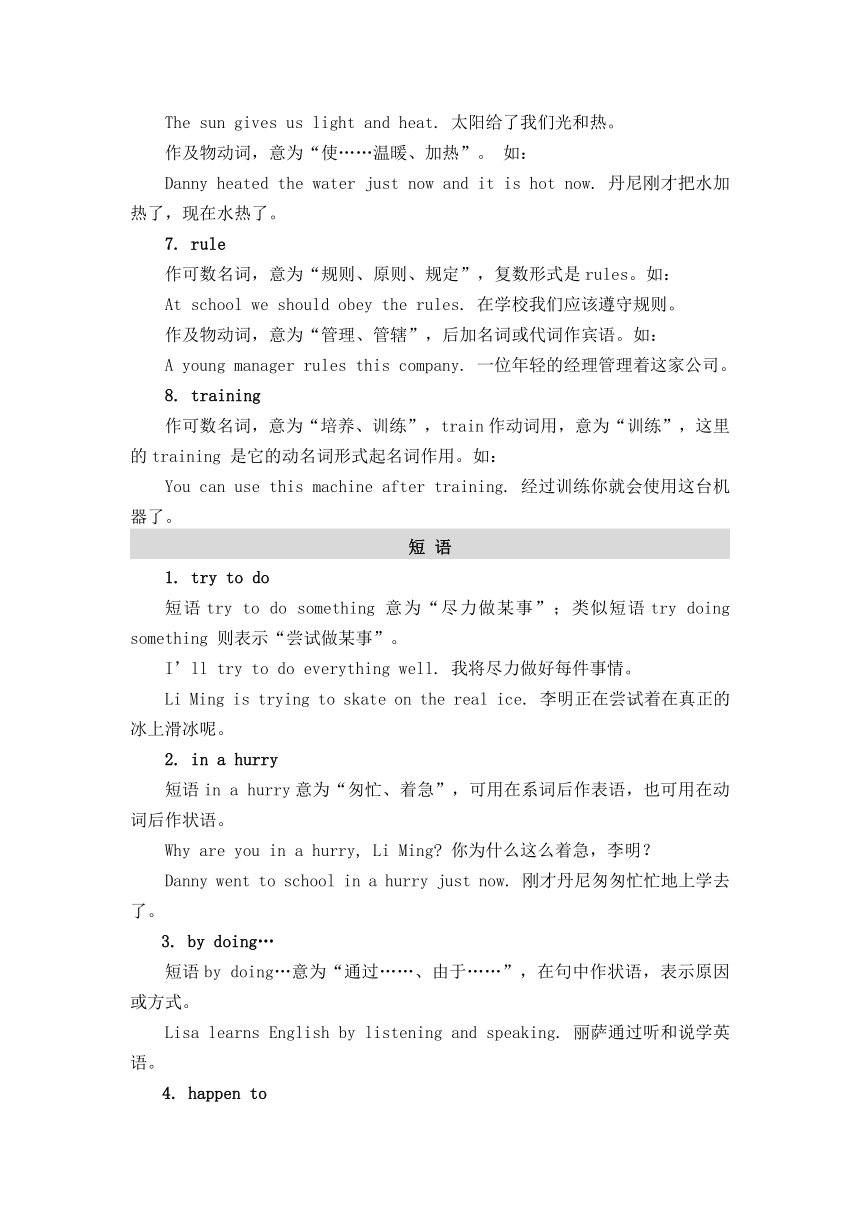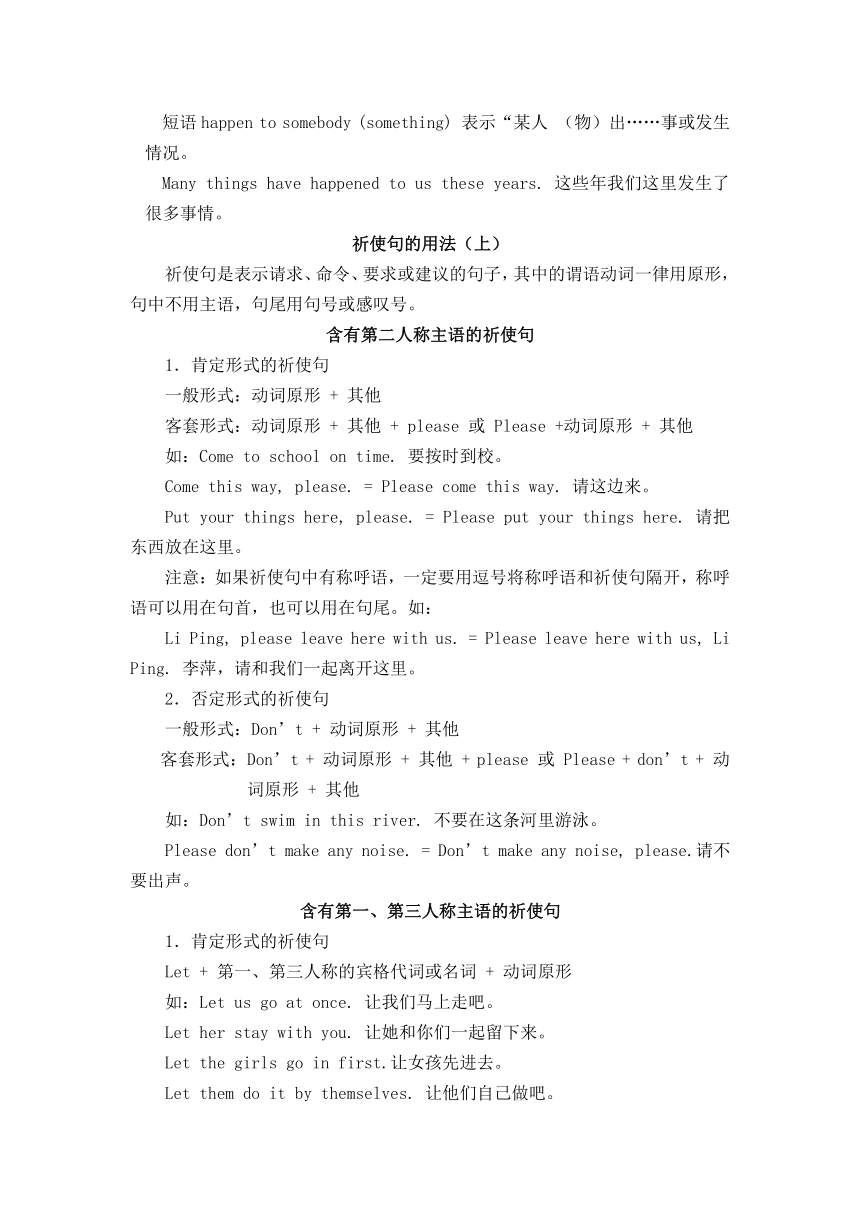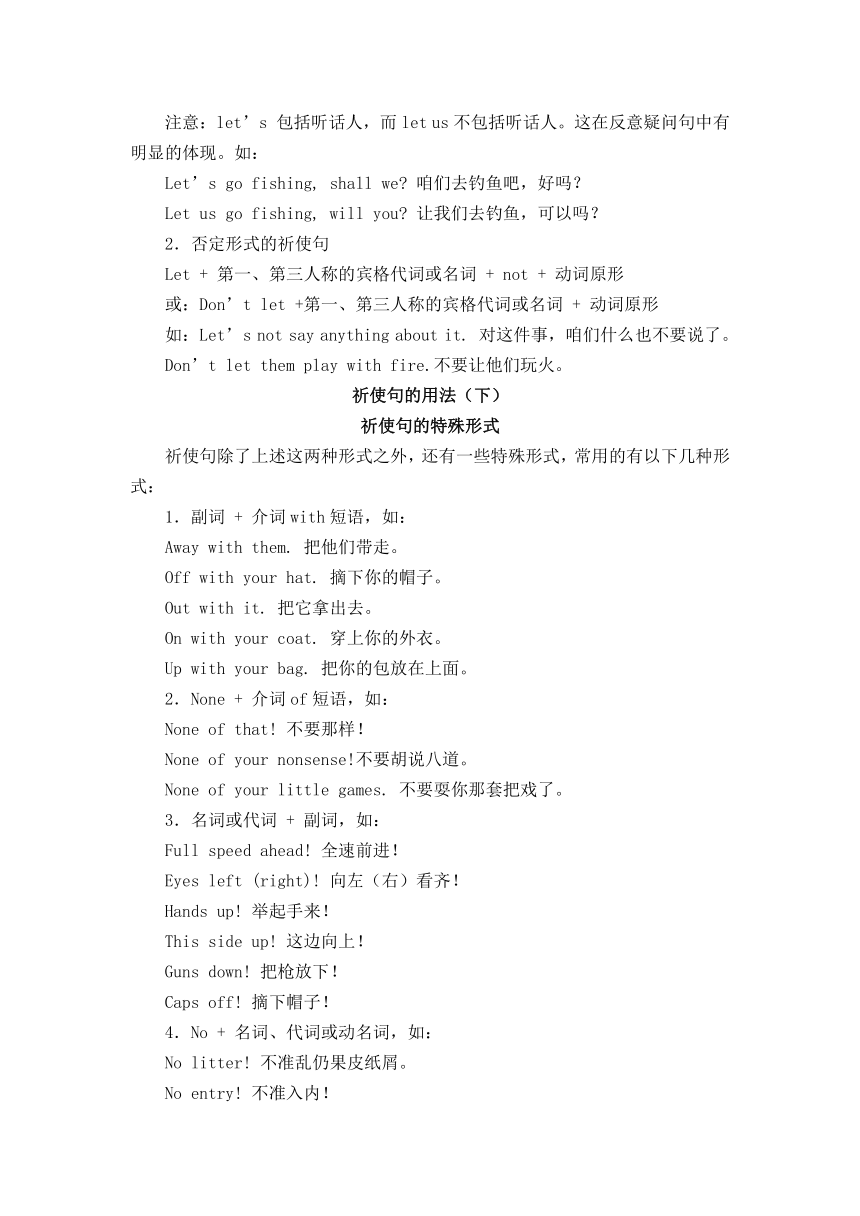Unit3 Safety单元知识点归纳
文档属性
| 名称 | Unit3 Safety单元知识点归纳 |  | |
| 格式 | docx | ||
| 文件大小 | 26.4KB | ||
| 资源类型 | 教案 | ||
| 版本资源 | 冀教版 | ||
| 科目 | 英语 | ||
| 更新时间 | 2023-10-18 19:35:20 | ||
图片预览




文档简介
Unit 3重点单词、短语回顾
单 词
1. careful
作形容词,意为“小心的、仔细的”,在句中作定语或表语。它的副词形式是carefully。如:
Please be careful when you cross the street. 当您横过街道时要当心。
2. hang
作及物动词,意为“悬挂”,后加名词或代词作宾语。过去式和过去分词都是hung。如:
Our teacher hung a map of China on the wall. 我们老师在墙上挂了一张中国地图。
作及物动词,意为“绞死、绞刑”过去式和过去分词都是hanged。如:
he murderer was hanged last week. 上周那个凶手被执行绞刑。
构成短语hang up, hang out,意思分别是“悬挂”,“闲逛”。 如:
Would you like to hang out in the store with me 你想要和我一起逛一逛市场吗?
3. wound
作可数名词,意为“伤口、伤害”,后加名词或代词作宾语。如:
Your wound is slightly infected. 你的伤口有点儿感染了。
wounded 表示“受伤的”,the wounded 表示“伤员”,是集体名词。如:
The doctor is trying to save the wounded soldiers. 医生正在抢救受伤的战士。
4. blood
作不可数名词,意为“血、血液、血统”。 如:
There is 83% of water in the blood. 血液中83%的成分是水。
5. stick
作可数名词,意为“棍棒、枝条”。 如:
You can tie the young tree to the stick. 你可以把小树绑在木棍上。
作及物动词, 意为“粘贴、穿入、坚持”,后加名词、代词、不定式作宾语。如:
Mr. Zhang stuck a map on the wall. 张先生在墙上粘了一张地图。
6. heat
作不可数名词,意为“热、热度”。 如:
The sun gives us light and heat. 太阳给了我们光和热。
作及物动词,意为“使……温暖、加热”。 如:
Danny heated the water just now and it is hot now. 丹尼刚才把水加热了,现在水热了。
7. rule
作可数名词,意为“规则、原则、规定”,复数形式是rules。如:
At school we should obey the rules. 在学校我们应该遵守规则。
作及物动词,意为“管理、管辖”,后加名词或代词作宾语。如:
A young manager rules this company. 一位年轻的经理管理着这家公司。
8. training
作可数名词,意为“培养、训练”,train作动词用,意为“训练”,这里的training 是它的动名词形式起名词作用。如:
You can use this machine after training. 经过训练你就会使用这台机器了。
短 语
1. try to do
短语try to do something 意为“尽力做某事”;类似短语try doing something 则表示“尝试做某事”。
I’ll try to do everything well. 我将尽力做好每件事情。
Li Ming is trying to skate on the real ice. 李明正在尝试着在真正的冰上滑冰呢。
2. in a hurry
短语in a hurry意为“匆忙、着急”,可用在系词后作表语,也可用在动词后作状语。
Why are you in a hurry, Li Ming 你为什么这么着急,李明?
Danny went to school in a hurry just now. 刚才丹尼匆匆忙忙地上学去了。
3. by doing…
短语by doing…意为“通过……、由于……”,在句中作状语,表示原因或方式。
Lisa learns English by listening and speaking. 丽萨通过听和说学英语。
4. happen to
短语happen to somebody (something) 表示“某人 (物)出……事或发生情况。
Many things have happened to us these years. 这些年我们这里发生了很多事情。
祈使句的用法(上)
祈使句是表示请求、命令、要求或建议的句子,其中的谓语动词一律用原形,句中不用主语,句尾用句号或感叹号。
含有第二人称主语的祈使句
1.肯定形式的祈使句
一般形式:动词原形 + 其他
客套形式:动词原形 + 其他 + please 或 Please +动词原形 + 其他
如:Come to school on time. 要按时到校。
Come this way, please. = Please come this way. 请这边来。
Put your things here, please. = Please put your things here. 请把东西放在这里。
注意:如果祈使句中有称呼语,一定要用逗号将称呼语和祈使句隔开,称呼语可以用在句首,也可以用在句尾。如:
Li Ping, please leave here with us. = Please leave here with us, Li Ping. 李萍,请和我们一起离开这里。
2.否定形式的祈使句
一般形式:Don’t + 动词原形 + 其他
客套形式:Don’t + 动词原形 + 其他 + please 或 Please + don’t + 动词原形 + 其他
如:Don’t swim in this river. 不要在这条河里游泳。
Please don’t make any noise. = Don’t make any noise, please.请不要出声。
含有第一、第三人称主语的祈使句
1.肯定形式的祈使句
Let + 第一、第三人称的宾格代词或名词 + 动词原形
如:Let us go at once. 让我们马上走吧。
Let her stay with you. 让她和你们一起留下来。
Let the girls go in first.让女孩先进去。
Let them do it by themselves. 让他们自己做吧。
注意:let’s 包括听话人,而let us不包括听话人。这在反意疑问句中有明显的体现。如:
Let’s go fishing, shall we 咱们去钓鱼吧,好吗?
Let us go fishing, will you 让我们去钓鱼,可以吗?
2.否定形式的祈使句
Let + 第一、第三人称的宾格代词或名词 + not + 动词原形
或:Don’t let +第一、第三人称的宾格代词或名词 + 动词原形
如:Let’s not say anything about it. 对这件事,咱们什么也不要说了。
Don’t let them play with fire.不要让他们玩火。
祈使句的用法(下)
祈使句的特殊形式
祈使句除了上述这两种形式之外,还有一些特殊形式,常用的有以下几种形式:
1.副词 + 介词with短语,如:
Away with them. 把他们带走。
Off with your hat. 摘下你的帽子。
Out with it. 把它拿出去。
On with your coat. 穿上你的外衣。
Up with your bag. 把你的包放在上面。
2.None + 介词of短语,如:
None of that! 不要那样!
None of your nonsense!不要胡说八道。
None of your little games. 不要耍你那套把戏了。
3.名词或代词 + 副词,如:
Full speed ahead! 全速前进!
Eyes left (right)! 向左(右)看齐!
Hands up! 举起手来!
This side up! 这边向上!
Guns down! 把枪放下!
Caps off! 摘下帽子!
4.No + 名词、代词或动名词,如:
No litter! 不准乱仍果皮纸屑。
No entry! 不准入内!
No smoking! 禁止吸烟!
No spitting! 不准随地吐痰!
No parking! 禁止停车!
5.有时为了起强调作用,you 可以出现在祈使句中。,如:
You keep quiet! 你要保持安静!
Don’t you worry! 你不要担心!
Unit 3易混淆词语辨析
1. happen, take place, break out
(1) happen作动词,意为“发生,碰巧”,指一切客观事物或情况的偶然或未能预见的发生。常与to连用, happen to sb. 表示某人发生了某事;happen to do sth. 表示碰巧作某事。如:
The accident happened yesterday. 事故发生在昨天。
Did you hear what happened to David last night 你听说大卫昨天晚上发生什么事了吗
(2) take place为固定词组,意为“发生,举行”,多指举行活动,指发生事先计划或预想到的事情。happen以及词组take place 等只能用作不及物动词,不能用被动语态形式。如:
The meeting took place at 8:00 as planned. 按计划会议在8点举行了。
(3) break out意思为“发生、爆发”,常指战争、灾难、疾病或者争吵等事件的发生,也可以表示突然大声叫喊等。如:
Two world wars broke out last century. 上个世纪两次世界大战爆发了。
2. put out, put up, put off, put away
(1) put out 意为“扑灭,熄灭”,还可以表示“生产,出版 ”。 如:
The soldiers and others managed to put out the fire.士兵和周围的人一同把火扑灭了。
This magazine is put out every Friday. 这份杂志每星期五出版。
(2) put up 意为“升起;举起 ”;还可以表示“ 建造;搭起” 。如:
If you have some questions, please put up your hands up. 如果你有问题,请举起手。
They put up a new house here. 他们在这里盖了一栋新房子。
(3) put off意为“推迟(约会、旅行、访问等);拖延”。 如:
It’s raining hard. We’d better put off the sports meeting. 正在下大雨,我们最好把运动会延期。
Never put off till tomorrow what you can do today. 今天的事不要拖到明天办。
(4) put away 意为“ 把(某物)收拾起来,把……收好”。 如:
Put your books away. 把你的书收好。
Your toys are scattered over the room. Please put them away. 你的玩具满屋乱放,请把它们放回原处。
祈使句主要用来表达请求、命令、建议、叮嘱或祝愿等。祈使句通常省略主语(you),但为了加强语气有时可以加上主语you或增加称呼。
1.行为动词开头的祈使句。Sit down.坐下吧!
2.Be开头的祈使句,后常加形容词。
Be careful! 当心!
3.Let...开头的祈使句。
Let me carry the box for you.
让我替你拿这个箱子吧!
Let’s+动词原形表建议,让我们……
Let’s go fishing this Sunday.
让我们这个周日去钓鱼。
Let’s=Let us,但不同语境有不同的含义。
Let’s“请让我们(咱们)……”,包括谈话的对方。
Let us意为“请让我们……”,表示希望得到对方允许,不包括对方。
4.祈使句的否定式。
行为动词和Be开头的祈使句,在句首加don’t。Don’t be late for
school.上学别迟到。
Let’s 的否定式可以有两种:Let’s not+动词原形或Don’t let’s+
动词原形。
Let’s not think about it.我们别想这事了。
Don’t let’s think about it.
5.祈使句的反意疑问句。
以行为动词或系词be或keep开头的祈使句,如果是肯定形式,后加will
you或won’t you构成。
Listen to me carefully, will you(won’t you)
如果祈使句是否定形式,常用will you。
Don’t speak so fast, will you 别说那么快,好吗
Let’s构成的祈使句,包括谈话双方,用shall we。
Let’s go for a walk, shall we
让我们出去散步,好吗
Let us构成的祈使句,不包括对方,请求对方允许,用will you。
Let us go there now, will you
让我们去那儿吧,好吗
注: (1)祈使句中常加do或always来加强肯定的语气,用never来加强否定
的语气。
Do be quiet a moment.务请安静一会儿。
Always remember all your father has said, and be a good boy.
要永远记住你爸爸的话,做一个好孩子。
Never trouble trouble till trouble troubles you.
麻烦不来找你,千万别去找麻烦。
祈使句中常加上please,表示礼貌,更客气。please可以放句首,也可以放句尾。放句末时要用逗号分开。Please open the door.=Open the door, please.
Unit 3重点句子讲解
1. I don’t think my arm is broken.
在动词think, believe, expect, guess等后面的宾语从句中的谓语动词如果是否定形式,这一否定形式往往转移到主句中,也就是主句成了否定形式,而从句成了肯定形式,但实际上还是否定的从句。如:
We don’t believe they can keep up with us. 我相信他们是不会赶上我们的。
2. I wanted to stop her from running after the ball, but she didn’t hear me.
句式stop … from doing … 意为“阻止……做某事”,其中的stop可用keep, prevent加以替换。如:
The heavy rain stopped us from having sports meeting. 大雨阻止了我们举行运动会。
3. “There is something wrong with me,” I thought.
由some, any, no, every 加上thing, body, one可以构成表示人或物的不定代词。比如something, anything, nothing, everything, somebody, anybody, nobody, everything等。以这类代词作主语时,谓语动词要用单数形式;并且形容词修饰这类不定代词时应该放在这些不定代词之后。如:
Everything is OK. Let’s begin our meeting. 一切都准备好了。咱们开会吧。
Is there anything new in today’s newspaper 今天的报纸上有什么新消息吗?
4. It’s easy to slip and fall on a wet floor.
不定式作主语时,往往用it作形式主语,而将不定式放在后面。这句话中的主语是to slip and fall on a wet floor, it是形式主语,is是系词,easy是表语。如:
To hear your voice is so nice. = It is nice to hear your voice. 听到你的声音真高兴。
To learn English well is very important. = It is very important to learn English well. 学好英语很重要。
5. I will never try to catch the falling dinosaur.
句中的falling 是现在分词作定语,意思是“正落下的”,修饰后面的名词dinosaur。过去分词也有这种用法。如:
Don’t wake up the sleeping boy. 不要叫醒那个熟睡的孩子。
The broken computer hasn’t been fixed yet. 那台坏电脑还没修好呢。
现在分词或过去分词短语作定语时则应该放在它们所修饰的名词之后。如:
Do you know the girl singing in the room 你认识正在房间里唱歌的那个女孩吗?
The table covered with paper is red. 用纸盖着的桌子是红色的。
6. I told her I would be careful.
这是带有宾语从句的复合句,主句为一般过去时,从句用的是过去将来时would be careful,在这里表示过去将要做某事。如:
The children said they wouldn’t play football in the street. 孩子们说不会在街上踢足球了。
He told me he would not go with us if it rained.他告诉我如果天下雨的话,他就不和我一起去了。
单 词
1. careful
作形容词,意为“小心的、仔细的”,在句中作定语或表语。它的副词形式是carefully。如:
Please be careful when you cross the street. 当您横过街道时要当心。
2. hang
作及物动词,意为“悬挂”,后加名词或代词作宾语。过去式和过去分词都是hung。如:
Our teacher hung a map of China on the wall. 我们老师在墙上挂了一张中国地图。
作及物动词,意为“绞死、绞刑”过去式和过去分词都是hanged。如:
he murderer was hanged last week. 上周那个凶手被执行绞刑。
构成短语hang up, hang out,意思分别是“悬挂”,“闲逛”。 如:
Would you like to hang out in the store with me 你想要和我一起逛一逛市场吗?
3. wound
作可数名词,意为“伤口、伤害”,后加名词或代词作宾语。如:
Your wound is slightly infected. 你的伤口有点儿感染了。
wounded 表示“受伤的”,the wounded 表示“伤员”,是集体名词。如:
The doctor is trying to save the wounded soldiers. 医生正在抢救受伤的战士。
4. blood
作不可数名词,意为“血、血液、血统”。 如:
There is 83% of water in the blood. 血液中83%的成分是水。
5. stick
作可数名词,意为“棍棒、枝条”。 如:
You can tie the young tree to the stick. 你可以把小树绑在木棍上。
作及物动词, 意为“粘贴、穿入、坚持”,后加名词、代词、不定式作宾语。如:
Mr. Zhang stuck a map on the wall. 张先生在墙上粘了一张地图。
6. heat
作不可数名词,意为“热、热度”。 如:
The sun gives us light and heat. 太阳给了我们光和热。
作及物动词,意为“使……温暖、加热”。 如:
Danny heated the water just now and it is hot now. 丹尼刚才把水加热了,现在水热了。
7. rule
作可数名词,意为“规则、原则、规定”,复数形式是rules。如:
At school we should obey the rules. 在学校我们应该遵守规则。
作及物动词,意为“管理、管辖”,后加名词或代词作宾语。如:
A young manager rules this company. 一位年轻的经理管理着这家公司。
8. training
作可数名词,意为“培养、训练”,train作动词用,意为“训练”,这里的training 是它的动名词形式起名词作用。如:
You can use this machine after training. 经过训练你就会使用这台机器了。
短 语
1. try to do
短语try to do something 意为“尽力做某事”;类似短语try doing something 则表示“尝试做某事”。
I’ll try to do everything well. 我将尽力做好每件事情。
Li Ming is trying to skate on the real ice. 李明正在尝试着在真正的冰上滑冰呢。
2. in a hurry
短语in a hurry意为“匆忙、着急”,可用在系词后作表语,也可用在动词后作状语。
Why are you in a hurry, Li Ming 你为什么这么着急,李明?
Danny went to school in a hurry just now. 刚才丹尼匆匆忙忙地上学去了。
3. by doing…
短语by doing…意为“通过……、由于……”,在句中作状语,表示原因或方式。
Lisa learns English by listening and speaking. 丽萨通过听和说学英语。
4. happen to
短语happen to somebody (something) 表示“某人 (物)出……事或发生情况。
Many things have happened to us these years. 这些年我们这里发生了很多事情。
祈使句的用法(上)
祈使句是表示请求、命令、要求或建议的句子,其中的谓语动词一律用原形,句中不用主语,句尾用句号或感叹号。
含有第二人称主语的祈使句
1.肯定形式的祈使句
一般形式:动词原形 + 其他
客套形式:动词原形 + 其他 + please 或 Please +动词原形 + 其他
如:Come to school on time. 要按时到校。
Come this way, please. = Please come this way. 请这边来。
Put your things here, please. = Please put your things here. 请把东西放在这里。
注意:如果祈使句中有称呼语,一定要用逗号将称呼语和祈使句隔开,称呼语可以用在句首,也可以用在句尾。如:
Li Ping, please leave here with us. = Please leave here with us, Li Ping. 李萍,请和我们一起离开这里。
2.否定形式的祈使句
一般形式:Don’t + 动词原形 + 其他
客套形式:Don’t + 动词原形 + 其他 + please 或 Please + don’t + 动词原形 + 其他
如:Don’t swim in this river. 不要在这条河里游泳。
Please don’t make any noise. = Don’t make any noise, please.请不要出声。
含有第一、第三人称主语的祈使句
1.肯定形式的祈使句
Let + 第一、第三人称的宾格代词或名词 + 动词原形
如:Let us go at once. 让我们马上走吧。
Let her stay with you. 让她和你们一起留下来。
Let the girls go in first.让女孩先进去。
Let them do it by themselves. 让他们自己做吧。
注意:let’s 包括听话人,而let us不包括听话人。这在反意疑问句中有明显的体现。如:
Let’s go fishing, shall we 咱们去钓鱼吧,好吗?
Let us go fishing, will you 让我们去钓鱼,可以吗?
2.否定形式的祈使句
Let + 第一、第三人称的宾格代词或名词 + not + 动词原形
或:Don’t let +第一、第三人称的宾格代词或名词 + 动词原形
如:Let’s not say anything about it. 对这件事,咱们什么也不要说了。
Don’t let them play with fire.不要让他们玩火。
祈使句的用法(下)
祈使句的特殊形式
祈使句除了上述这两种形式之外,还有一些特殊形式,常用的有以下几种形式:
1.副词 + 介词with短语,如:
Away with them. 把他们带走。
Off with your hat. 摘下你的帽子。
Out with it. 把它拿出去。
On with your coat. 穿上你的外衣。
Up with your bag. 把你的包放在上面。
2.None + 介词of短语,如:
None of that! 不要那样!
None of your nonsense!不要胡说八道。
None of your little games. 不要耍你那套把戏了。
3.名词或代词 + 副词,如:
Full speed ahead! 全速前进!
Eyes left (right)! 向左(右)看齐!
Hands up! 举起手来!
This side up! 这边向上!
Guns down! 把枪放下!
Caps off! 摘下帽子!
4.No + 名词、代词或动名词,如:
No litter! 不准乱仍果皮纸屑。
No entry! 不准入内!
No smoking! 禁止吸烟!
No spitting! 不准随地吐痰!
No parking! 禁止停车!
5.有时为了起强调作用,you 可以出现在祈使句中。,如:
You keep quiet! 你要保持安静!
Don’t you worry! 你不要担心!
Unit 3易混淆词语辨析
1. happen, take place, break out
(1) happen作动词,意为“发生,碰巧”,指一切客观事物或情况的偶然或未能预见的发生。常与to连用, happen to sb. 表示某人发生了某事;happen to do sth. 表示碰巧作某事。如:
The accident happened yesterday. 事故发生在昨天。
Did you hear what happened to David last night 你听说大卫昨天晚上发生什么事了吗
(2) take place为固定词组,意为“发生,举行”,多指举行活动,指发生事先计划或预想到的事情。happen以及词组take place 等只能用作不及物动词,不能用被动语态形式。如:
The meeting took place at 8:00 as planned. 按计划会议在8点举行了。
(3) break out意思为“发生、爆发”,常指战争、灾难、疾病或者争吵等事件的发生,也可以表示突然大声叫喊等。如:
Two world wars broke out last century. 上个世纪两次世界大战爆发了。
2. put out, put up, put off, put away
(1) put out 意为“扑灭,熄灭”,还可以表示“生产,出版 ”。 如:
The soldiers and others managed to put out the fire.士兵和周围的人一同把火扑灭了。
This magazine is put out every Friday. 这份杂志每星期五出版。
(2) put up 意为“升起;举起 ”;还可以表示“ 建造;搭起” 。如:
If you have some questions, please put up your hands up. 如果你有问题,请举起手。
They put up a new house here. 他们在这里盖了一栋新房子。
(3) put off意为“推迟(约会、旅行、访问等);拖延”。 如:
It’s raining hard. We’d better put off the sports meeting. 正在下大雨,我们最好把运动会延期。
Never put off till tomorrow what you can do today. 今天的事不要拖到明天办。
(4) put away 意为“ 把(某物)收拾起来,把……收好”。 如:
Put your books away. 把你的书收好。
Your toys are scattered over the room. Please put them away. 你的玩具满屋乱放,请把它们放回原处。
祈使句主要用来表达请求、命令、建议、叮嘱或祝愿等。祈使句通常省略主语(you),但为了加强语气有时可以加上主语you或增加称呼。
1.行为动词开头的祈使句。Sit down.坐下吧!
2.Be开头的祈使句,后常加形容词。
Be careful! 当心!
3.Let...开头的祈使句。
Let me carry the box for you.
让我替你拿这个箱子吧!
Let’s+动词原形表建议,让我们……
Let’s go fishing this Sunday.
让我们这个周日去钓鱼。
Let’s=Let us,但不同语境有不同的含义。
Let’s“请让我们(咱们)……”,包括谈话的对方。
Let us意为“请让我们……”,表示希望得到对方允许,不包括对方。
4.祈使句的否定式。
行为动词和Be开头的祈使句,在句首加don’t。Don’t be late for
school.上学别迟到。
Let’s 的否定式可以有两种:Let’s not+动词原形或Don’t let’s+
动词原形。
Let’s not think about it.我们别想这事了。
Don’t let’s think about it.
5.祈使句的反意疑问句。
以行为动词或系词be或keep开头的祈使句,如果是肯定形式,后加will
you或won’t you构成。
Listen to me carefully, will you(won’t you)
如果祈使句是否定形式,常用will you。
Don’t speak so fast, will you 别说那么快,好吗
Let’s构成的祈使句,包括谈话双方,用shall we。
Let’s go for a walk, shall we
让我们出去散步,好吗
Let us构成的祈使句,不包括对方,请求对方允许,用will you。
Let us go there now, will you
让我们去那儿吧,好吗
注: (1)祈使句中常加do或always来加强肯定的语气,用never来加强否定
的语气。
Do be quiet a moment.务请安静一会儿。
Always remember all your father has said, and be a good boy.
要永远记住你爸爸的话,做一个好孩子。
Never trouble trouble till trouble troubles you.
麻烦不来找你,千万别去找麻烦。
祈使句中常加上please,表示礼貌,更客气。please可以放句首,也可以放句尾。放句末时要用逗号分开。Please open the door.=Open the door, please.
Unit 3重点句子讲解
1. I don’t think my arm is broken.
在动词think, believe, expect, guess等后面的宾语从句中的谓语动词如果是否定形式,这一否定形式往往转移到主句中,也就是主句成了否定形式,而从句成了肯定形式,但实际上还是否定的从句。如:
We don’t believe they can keep up with us. 我相信他们是不会赶上我们的。
2. I wanted to stop her from running after the ball, but she didn’t hear me.
句式stop … from doing … 意为“阻止……做某事”,其中的stop可用keep, prevent加以替换。如:
The heavy rain stopped us from having sports meeting. 大雨阻止了我们举行运动会。
3. “There is something wrong with me,” I thought.
由some, any, no, every 加上thing, body, one可以构成表示人或物的不定代词。比如something, anything, nothing, everything, somebody, anybody, nobody, everything等。以这类代词作主语时,谓语动词要用单数形式;并且形容词修饰这类不定代词时应该放在这些不定代词之后。如:
Everything is OK. Let’s begin our meeting. 一切都准备好了。咱们开会吧。
Is there anything new in today’s newspaper 今天的报纸上有什么新消息吗?
4. It’s easy to slip and fall on a wet floor.
不定式作主语时,往往用it作形式主语,而将不定式放在后面。这句话中的主语是to slip and fall on a wet floor, it是形式主语,is是系词,easy是表语。如:
To hear your voice is so nice. = It is nice to hear your voice. 听到你的声音真高兴。
To learn English well is very important. = It is very important to learn English well. 学好英语很重要。
5. I will never try to catch the falling dinosaur.
句中的falling 是现在分词作定语,意思是“正落下的”,修饰后面的名词dinosaur。过去分词也有这种用法。如:
Don’t wake up the sleeping boy. 不要叫醒那个熟睡的孩子。
The broken computer hasn’t been fixed yet. 那台坏电脑还没修好呢。
现在分词或过去分词短语作定语时则应该放在它们所修饰的名词之后。如:
Do you know the girl singing in the room 你认识正在房间里唱歌的那个女孩吗?
The table covered with paper is red. 用纸盖着的桌子是红色的。
6. I told her I would be careful.
这是带有宾语从句的复合句,主句为一般过去时,从句用的是过去将来时would be careful,在这里表示过去将要做某事。如:
The children said they wouldn’t play football in the street. 孩子们说不会在街上踢足球了。
He told me he would not go with us if it rained.他告诉我如果天下雨的话,他就不和我一起去了。
同课章节目录
- Unit 1 Stay Healthy
- Lesson 1 What's Wrong,Danny?
- Lesson 2 A Visit to the Dentist
- Lesson 3 Good Food, Good Health
- Lesson 4 Don't Smoke, Please!
- Lesson 5 Jane's Lucky Life
- Lesson 6 Stay Away from the Hospital
- Unit Review
- Unit 2 Great People
- Lesson 7 What Is the Meaning of Lift?
- Lesson 8 A Universe of Thought
- Lesson 9 China's Most Famous "Farmer"
- Lesson 10 Touch the World
- Lesson 11 To China, with Love
- Lesson 12 Guess My Hero!
- Unit Review
- Unit 3 Safety
- Lesson 13 Be Careful,Danny!
- Lesson 14 Accidents Happen
- Lesson 15 My Helmet Saved My Life!
- Lesson 16 How Safe Is Your Home?
- Lesson 17 Staying Safe in an Earthquake
- Lesson 18 Never Catch a Dinosaur
- Unit Review
- Unit 4 Stories and poems
- Lesson 19 A Story or a Poem?
- Lesson 20 Say It in Five
- Lesson 21 The Fable of the Woodcutte
- Lesson 22 The Giant(Ⅰ)
- Lesson 23 The Giant(Ⅱ)
- Lesson 24 Writing a Poem
- Unit Review
- Unit 5 Look into Science
- Lesson 25 Let's Do an Experiment!
- Lesson 26 Keep the Candle Burning
- Lesson 27 Planet Danny
- Lesson 28 The Study of Living Things
- Lesson 29 DNA—The Story of You
- Lesson 30 Science Affects Us
- Unit Review
- Unit 6 Movies and Theate
- Lesson 31 A movie or a Play
- Lesson 32 Moving Pictures
- Lesson 33 The Fisherman and the Goldfish(Ⅰ)
- Lesson 34 The Fisherman and the Goldfish(Ⅱ)
- Lesson 35 Theatres Are Fun!
- Lesson 36 Making Plays Is Fun
- Unit Review
